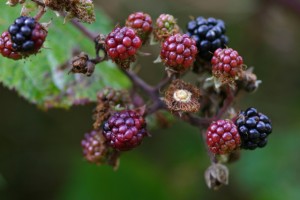 Now is the time of the year to start planning to sample some of the wild food available in hedgerows, woodland and moorland. For many people this idea seems deeply rooted in the world famous book by Richard Mabey entitled “Food for Free” and first published in 1972. The book may have served as catalyst for many people but this approach to gathering berries, fruit, blossoms, mushrooms etc. etc. started since time immemorial. However, Richard Mabey’s book was still an important milestone and the fact it has been published in so many editions and revisions speaks for itself. There are many other books on the subject, particularly in the last five years, but that original one is still my favourite and the one I refer to more than any other. To my mind by far the best edition is the large format hardback book published by HarperCollins in 2012. However, there are other useful editions including some that are designed to fit into the pocket or rucksack so that they can be used first hand – out in the field.
Now is the time of the year to start planning to sample some of the wild food available in hedgerows, woodland and moorland. For many people this idea seems deeply rooted in the world famous book by Richard Mabey entitled “Food for Free” and first published in 1972. The book may have served as catalyst for many people but this approach to gathering berries, fruit, blossoms, mushrooms etc. etc. started since time immemorial. However, Richard Mabey’s book was still an important milestone and the fact it has been published in so many editions and revisions speaks for itself. There are many other books on the subject, particularly in the last five years, but that original one is still my favourite and the one I refer to more than any other. To my mind by far the best edition is the large format hardback book published by HarperCollins in 2012. However, there are other useful editions including some that are designed to fit into the pocket or rucksack so that they can be used first hand – out in the field.
According to various people this year may have started badly with the late cold spring but, with the weather we have had since, there promises to be a late, but heavy, crop of berries, fruits etc. to look forward to. Certainly many of the berries and other foods are looking promising and some are well formed such as the wild raspberries that seem to have a good crop. The blackbirds have already been plundering the raspberries as soon as they ripen and the birds often look almost comical as they try to balance on the thin outer twigs whilst reaching out for the berries. The rowan trees I have looked at also seem to have a rich harvest to come with the well formed berries, not red yet, hanging heavily on the branches. In contrast I have just looked at the nearest blackthorn bushes in the strath but there seems to be no berries even forming but perhaps it is just that particular line of bushes.
With all the books coming out on this subject you would think that the wild harvest is being gathered by very many people each year. However, there seems to be signs that the reverse is taking place. For example around Inverness you would often see people gathering brambles, some people call them blackberries, or the signs of paths pushing into dense bushes. This no longer seems to be the case. The same with blackthorn berries, the famous sloes, as it in the past I would often meet people at the local line of bushes intent, as I was, on making sloe gin or sloe whisky. The same can be said for people collecting wild mushrooms, fungi to some people, as I just do not see the people any more, certainly in this strath. How widespread this is in the Highlands is difficult to judge but there does definitely seem to be a downward trend in gathering this “Food for Free”. There is such a wide variety to gather such as rowans berries to make rowan jelly. In a normal year the berries are best collected in October when they have their full colour and have not turn mushy. The resulting jelly is a delicious dark orange with a sharp marmalade flavour and goes perfectly with game, such as venison, and lamb. Remember not to take too many berries and fruits from the wild as the wild birds also need them. Good hunting.
